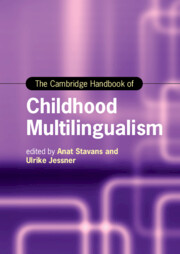Book contents
- The Cambridge Handbook of Childhood Multilingualism
- Cambridge Handbooks in Language and Linguistics
- The Cambridge Handbook of Childhood Multilingualism
- Copyright page
- Contents
- Figures
- Tables
- About the Editors
- Contributors
- Acknowledgments
- Multilingualism Is Not Bilingualism +1: An Introduction
- Part One Becoming and Being a Multilingual Child
- Part Two Cognition and Faculties in Multilinguals
- 5 Language and Thought in Multilingual Children
- 6 Multilingual Exposure and Children’s Effective Communication
- 7 Metalinguistic Awareness and Early Multilingual Learning
- 8 Code-Switching among Bilingual and Trilingual Children
- 9 Children’s Perception of Their Multilingualism
- 10 Multilingualism and Language Play
- Part Three Family Language Policy
- Part Four Language(s) and Literacy of Multilingual Children through Schooling
- Part Five Socialization in Childhood Multilingualism
- Part Six Multilingual Children’s Landscape
- Subject Index
- Country Index
- Language Index
- References
5 - Language and Thought in Multilingual Children
from Part Two - Cognition and Faculties in Multilinguals
Published online by Cambridge University Press: 18 August 2022
- The Cambridge Handbook of Childhood Multilingualism
- Cambridge Handbooks in Language and Linguistics
- The Cambridge Handbook of Childhood Multilingualism
- Copyright page
- Contents
- Figures
- Tables
- About the Editors
- Contributors
- Acknowledgments
- Multilingualism Is Not Bilingualism +1: An Introduction
- Part One Becoming and Being a Multilingual Child
- Part Two Cognition and Faculties in Multilinguals
- 5 Language and Thought in Multilingual Children
- 6 Multilingual Exposure and Children’s Effective Communication
- 7 Metalinguistic Awareness and Early Multilingual Learning
- 8 Code-Switching among Bilingual and Trilingual Children
- 9 Children’s Perception of Their Multilingualism
- 10 Multilingualism and Language Play
- Part Three Family Language Policy
- Part Four Language(s) and Literacy of Multilingual Children through Schooling
- Part Five Socialization in Childhood Multilingualism
- Part Six Multilingual Children’s Landscape
- Subject Index
- Country Index
- Language Index
- References
Summary
A large body of research has contributed to a complex picture in which bilingualism is generally associated with better performance on some cognitive tasks, particularly those that are based on executive functioning, but poorer performance on measures of verbal proficiency. However, not all studies find these effects, particularly the positive effects on cognitive function. What is now clear is that the potential impact of bilingualism on children’s cognition must be explained through multifaceted examinations of relevant factors and clarification of the specific language context from which the results emerged on an individual basis. We review the evidence for cognitive performance of children in multilingual environments and evaluate those results in terms of the type of cognitive ability being assessed and the type of environment children are experiencing. We also review how early the effects of multilingualism are detected, how long these effects last, and how childhood multilingualism can lead to brain plasticity. We conclude with a brief discussion of how multilingualism impacts other areas of cognitive functioning, such as theory of mind, creativity, and problem solving.
- Type
- Chapter
- Information
- The Cambridge Handbook of Childhood Multilingualism , pp. 113 - 140Publisher: Cambridge University PressPrint publication year: 2022
References
- 1
- Cited by



